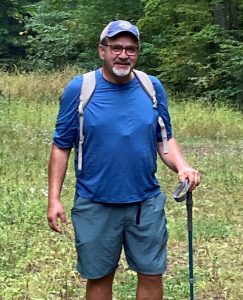Our Stories
James Deich: NCNST Long Distance Hiker
James Deich
Wisconsin
Wisconsin

Having completed the Ice Age Trail in December 2021, I was looking for a new adventure and decided to hike the Wisconsin section of the North Country National Scenic Trail in 2022. I selected the trail partly due to its proximity to my home in Eau Claire, Wisconsin and to get a better understanding of the geology of the area, after reading the Gene LaBerge book, Geology of the Lake Superior Region. I was not disappointed. I started hiking east on the Trail at Highway 23 in Carlton County, Minnesota on June 14. The Trail, which runs through the northern four Wisconsin counties bordering the south edge of Lake Superior, was completed by a series of section hikes.
My interest in the geology of the area was quickly piqued by my view of the St. Croix horst while hiking along the Douglas fault and coming to Big Manitou Falls at Pattison State Park. Being the tallest falls in Wisconsin, Big Manitou was the first of several beautiful waterfalls along the route. Moving through the country, I was struck by the tranquility along the Trail. I did not pass another hiker on that trail until I entered the Chequamegon National Forest. Ice age features abound, created by glaciers that moved south from Lake Superior. The uneven ground along the St. Croix River below the Gordon Dam is made up of many small rocks as you would find at the bottom of a fast-moving stream since it is part of a larger ancient riverbed. This and the width of the river valley show the effects of the large volume of glacial melt water which came from glacial Lake Duluth, by way of the Brule River and emptying into the St. Croix.
Deer flies during the month of July were the biggest hindrance along the Trail. They forced me to keep moving. The Trail gives many scenic views of the beautiful Brule River Valley. The Chequamegon-Nicolet National Forest is a treat. Without looking at your map, you sense that you are in the National Forest due to the beauty. It gets even better when you enter the Rainbow Lake Wilderness Area. You are forced to pay closer attention to where you are, due to there being fewer trail markings. The Trail goes through Drummond Wood, an old growth forest. Having escaped the loggers’ saw, it is interesting to imagine what the forests of Wisconsin looked like prior to European settlers. Nearby on the shores of Lake Owen, the Trail passes through an area used by early Archean Indians 4,000 years ago. There were villages, from around the year 0 until the 1600s.
While hiking, you have a lot of time to ponder different questions, such as where is the most beautiful spot on the Trail you are hiking. Porcupine Lake and Creek in the Porcupine Wilderness Area could be that place. Copper Falls State Park would have to be a close runner-up for me. The final treat was the hike to Lake Superior at Saxon Harbor, a beautiful marina destroyed by a flood on Oronto Creek in 2016. There is a wonderful view of the lake at the new marina which reconstruction was completed in 2021. It was fun crossing the Montreal River bridge and going into the State of Michigan.
Upon completing the Wisconsin section of the North Country Trail, my wife and trail angel Faye, who has repeatedly extracted me out of the wilderness, went on to celebrate with me by hiking the St. Peter’s Dome Trail on the afternoon of November 3, 2022.
Learn more about long distance hiker recognition at explorenct.info/NoCoLo/index.htm.
